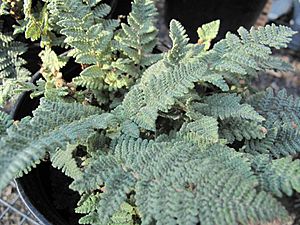Myriopteris tomentosa facts for kids
Quick facts for kids Myriopteris tomentosa |
|
|---|---|
 |
|
| A cultivated woolly lipfern | |
| Conservation status | |
| Scientific classification | |
| Genus: |
Myriopteris
|
| Species: |
tomentosa
|
| Synonyms | |
|
|
The woolly lipfern (scientific name: Myriopteris tomentosa) is a type of fern that lives for many years. It used to be called Cheilanthes tomentosa. This fern grows naturally in the southern parts of the United States, from Arizona to Georgia, and also in Mexico.
Contents
About the Woolly Lipfern
The woolly lipfern is a small evergreen fern. This means it stays green all year round. It grows in clumps and has soft hairs on most of its leaves.
Its underground stem, called a rhizome, is small and usually about 2 to 8 millimeters (0.08 to 0.3 inches) wide. The rhizome has scales that are 3 to 4 millimeters (0.12 to 0.16 inches) long. These scales are narrow and have a dark center with light brown edges.
The fern's leaves, called fronds, grow in groups from the rhizome. Unlike many ferns, they do not start as tightly coiled "fiddleheads." When fully grown, the fronds are 8 to 45 centimeters (3 to 18 inches) long and 1.5 to 8 centimeters (0.6 to 3 inches) wide. Both the fertile (spore-producing) and sterile fronds look similar.
The stalk of the leaf, called the stipe, is 5 to 20 centimeters (2 to 8 inches) long. It is usually about one-third of the frond's total length. The stipe is dark brown and covered with woolly, orange-tan hairs.
The main part of the leaf, called the blade, is shaped like a long oval. It is usually divided into many smaller parts near its base. Each blade has about 20 pairs of side branches called pinnae. These pinnae are spread out at the bottom of the blade but get closer together near the tip. The blades are gray-green.
The main stem of the leaf, called the rachis, is dark brown and has soft hairs. The pinnae are not jointed at their base. The smallest parts of the leaf are tiny and bead-like, about 1 to 2 millimeters (0.04 to 0.08 inches) long. The top surface of the leaf has fine, soft hairs. The bottom surface is covered with a thick mat of woolly hairs.
This fern can shrivel up and look dead during dry periods. However, it will come back to life when it gets moisture again.
How Woolly Lipfern Reproduces
On fertile fronds, the sori (which are groups of spore cases) are protected by the curled-back edge of the leaf. This curled edge acts like a cover, called a false indusium. The sori are found along this curled edge.
Each sporangium (spore case) in a sorus holds 32 brown spores. The fern reproduces in a special way called apogamy. This means that the spores are formed without the usual process of meiosis. These spores then grow into new ferns that are genetically identical to the parent plant, without needing fertilization.
Naming the Woolly Lipfern
The common name "lip fern" comes from where the spore cases are located. They are found at the edge, or "lip," of the leaf. The word "woolly" describes the thick, matted hairs on the underside of the leaf. The scientific name tomentosa also means "covered with dense, matted hairs."
The woolly lipfern was first described in 1833 by J. H. F. Link. He named it Cheilanthes tomentosa. For many years, most scientists kept it in the Cheilanthes group.
However, some botanists thought it belonged in other groups. In 1852, A.L.A. Fée created a new group called Myriopteris. He moved C. tomentosa to this new group, calling it Myriopteris tomentosa. He did this because of the hairs found among the spore cases and certain features of the leaf's protective cover.
Later, in 1852, William Jackson Hooker described a very similar fern as Cheilanthes bradburii. It turned out that what Hooker called C. bradburii was actually the same as Link's C. tomentosa.
Over time, scientists continued to study ferns. In 2013, new studies using DNA showed that the traditional Cheilanthes group was not correctly organized. Based on this new evidence, scientists Amanda Grusz and Michael D. Windham brought back the Myriopteris group. So, C. tomentosa became Myriopteris tomentosa once again.
Further DNA studies showed that Myriopteris has three main groups. The woolly lipfern belongs to a group where the leaves are finely divided into bead-like segments. Many ferns in this group, including the woolly lipfern, reproduce by apogamy.
Where Woolly Lipfern Lives
Myriopteris tomentosa is found in Mexico, from Veracruz north and west to Sonora. In the United States, it grows in the southwestern states, including Texas, Oklahoma, Arkansas, and Missouri. It also lives in the Appalachian Mountains, from Alabama through Virginia and West Virginia. Reports of it growing in Pennsylvania were incorrect.
Woolly lipfern usually grows on rocky slopes, in cracks in rocks, and on ledges. It can be found on different types of rocks, like limestone or granite. It grows at elevations from 200 to 400 meters (about 650 to 1,300 feet) above sea level.
Conservation Status
The woolly lipfern is considered "globally secure" (G5). This means it is common and not in danger worldwide. However, in a few states at the edge of its range, it is more rare. For example, it is only known from historical records in Kansas. NatureServe says it is "critically imperiled" (very rare and at high risk) in Missouri and West Virginia.
Growing Woolly Lipfern
Myriopteris tomentosa can be grown in gardens. It prefers soil that is moist to dry, well-drained, and sandy. It is fairly easy to grow compared to some other ferns in its group. It needs a lot of light or full sun to grow well.
Images for kids



